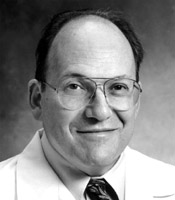NIH Award from the National Cancer Institute
Radiation Biology of EPR Oxygen Images
- Principal Investigator: Howard Halpern, MD, PhD, Associate Professor, Department of Radiation and Cellular Oncology, Cancer Research Center, Committee on Cancer Biology
- Start Date: June 8, 2009
- Total Award Amount: $273,274 (first year) $279,290 (second year)
Public Health Relevance
This work continues the investigation of a new technique to predict cure likelihood of the radiation of cancers and to use the technique to improve the cure of cancers with radiation. The technique involves a non-invasive electron magnetic resonance image of animal tumors after the injection of a non-toxic small molecule compound that reports through its electron magnetic resonance spectrum, the amount of oxygen in each of the 1mm volumes of the tumor. This eventually will be developed for human tumor measurements.
Project Description
Radiation Biology of EPR Oxygen Images Abstract: Electron Paramagnetic Resonance (EPR) Oxygen Images (EPROI) have been shown to provide quantitative localized pO2 images in FSa fibro sarcomas grown in the legs of C3H mice. The widths of narrow EPR spectral lines report the pO2 of 1-3 tore resolution in each 1 mm3 image voxel. This work has shown
- the first co-localized correlation between an oxygen image and a point oxygen measurement technique (Oxylite)
- independent, statistically significant sharpening of the 50% tumor control dose with the addition of the information provided by the fraction of EPROI voxels less than 10 torr (HF10)
- co- registration of pimonidazole images with EPROI oxygen gradients and
- significant spatial correlation of VEGF and EPROI based HF10.
We propose the following specific aims for the next funding cycle:
- Determining the relation between the localized oxygen information from the EPROI and pimonidazole retention, induction of other hypoxia proteins and single biopsy hypoxic fraction.
- Treatment of murine tumors to TCD50 after oxygen images and determining the predictive effectiveness of the HF10 and other EPROI tumor statistics and
- Using the HF10 from EPROI to dose paint regions of hypoxia with IMRT to determine the impact of the EPROI on cure of rat tumors.
This award is funded under the American Recovery and Reinvestment Act of 2009, NIH Award number: 2R01CA098575-05A1

Howard Halpern, MD, PhD,
Associate Professor, Department of Radiation and Cellular Oncology, Cancer Research Center, Committee on Cancer Biology
